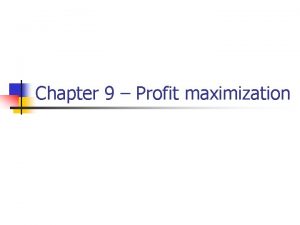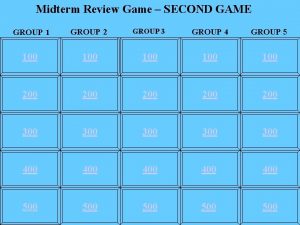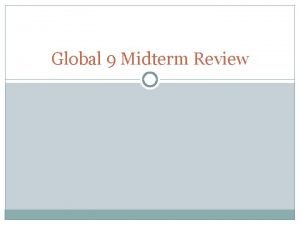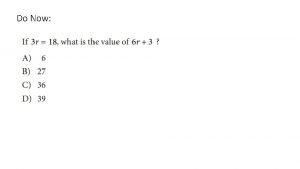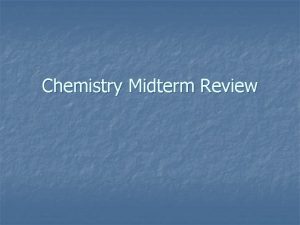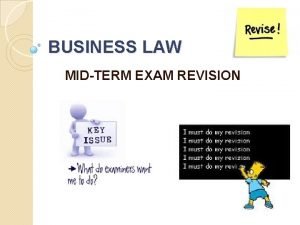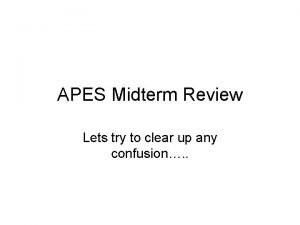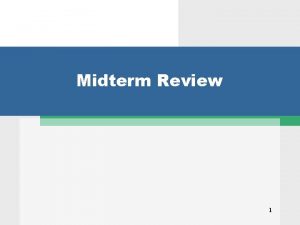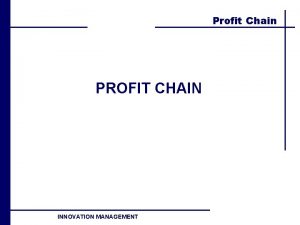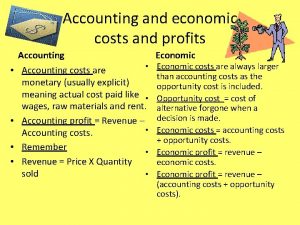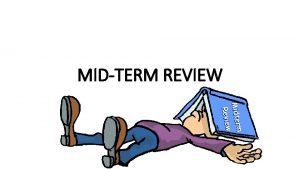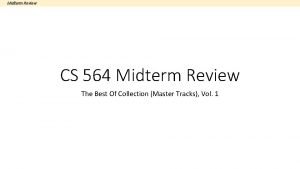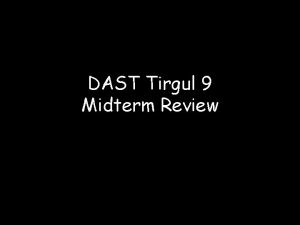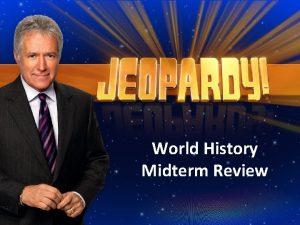Midterm 2 Review Economic Profit vs Accounting Profit














- Slides: 14

Midterm #2 Review

Economic Profit vs Accounting Profit • Accounting Profit = Total Income – Expenses • Economic Profit = Total Income – Total Expenses – Opportunity Cost üA firm will stay in business as long as its Economic Profits are = > 0

Law of Diminishing Marginal Utility • As consumption of a good increases (other goods ceteris parabus)…. – Marginal utility (satisfaction/want/need) from consumption of one more of that item will decrease üAll-you-can-eat buffet

Law of Diminishing Marginal Returns • As the number of employees increases… – The marginal product of an additional employee will, at some point, be less than the marginal product of the last employee

Costs • Short Run Costs – Understand Fixed Costs – Understand Variable Costs – Relationship between short run costs and quantity • Total Cost Curve • Average Cost Curve • Marginal Cost Curve – Relationship between diminishing returns and • Long Run Costs – Relationship between long run costs and quantity • Total Cost Curve • Economies of Scale • Marginal Cost Curve

Perfect Competition 1. All firms sell an identical product. 2. All firms are price takers. 3. All firms have a relatively small market share. 4. Buyers know the nature of the product being sold and the prices charged by each firm. 5. The industry is characterized by freedom of entry and exit.

Monopoly • 1. There is a single seller • 2. There are no close substitutes for the firm’s product • 3. There are barriers to entry

Monopolistic Competition • 1. All firms produce similar yet not perfectly substitutable products. 2. All firms are able to enter the industry if the profits are attractive. 3. All firms are profit maximizers. 4. All firms have some market power, which means none are price takers.

Oligopoly • A few firms selling similar product • Each firm produces branded products • Likely to be significant entry barriers into the market in the long run which allows firms to make supernormal profits. • Interdependence between competing firms. Businesses have to take into account likely reactions of rivals to any change in price and output

Gaming Theory • Prisoners Dilemma • Nash Equilibrium


Consumer Prices/Inflation • Nominal rates • Real rates • Nominal growth = real growth rate + inflation

Economic Growth • Technical Advancement, allocation of resources, production possibilities frontier

Summary • Review sheet will be posted on blog NLT 21 Nov • Test Format – Definitions – Short Answer • Do not wait until the night before to prepare
 Accounting profit vs economic profit
Accounting profit vs economic profit Economic profit vs accounting profit
Economic profit vs accounting profit Pons mnemonic
Pons mnemonic Algebra 1 midterm exam
Algebra 1 midterm exam Whap midterm review
Whap midterm review Marketing midterm review
Marketing midterm review Global 9 midterm review
Global 9 midterm review Trig midterm review
Trig midterm review Which substance can be decomposed chemically
Which substance can be decomposed chemically Business law midterm review
Business law midterm review Apes midterm practice test
Apes midterm practice test Ap chemistry midterm
Ap chemistry midterm Algebra 2 midterm exam
Algebra 2 midterm exam Spanish 2 midterm review
Spanish 2 midterm review English 1 midterm exam
English 1 midterm exam
